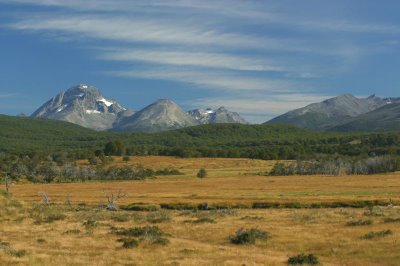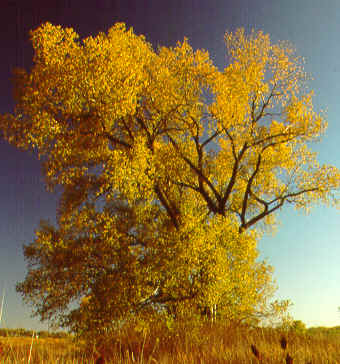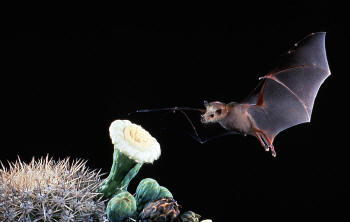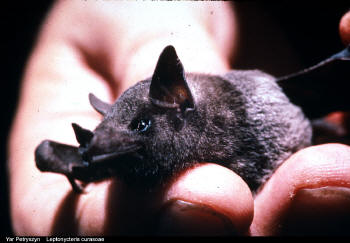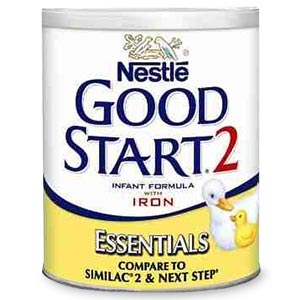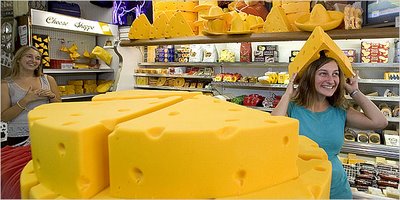 Sophie Horton, right, of Chicago tried on a cheesehead hat with her friend Alex Marohn, far left, of Sheboygan, Wis., from among many shapes, including top hat, cowboy hat, fireman’s hat, sombrero and crown. Image Credit: Andy Manis for The New York Times
Sophie Horton, right, of Chicago tried on a cheesehead hat with her friend Alex Marohn, far left, of Sheboygan, Wis., from among many shapes, including top hat, cowboy hat, fireman’s hat, sombrero and crown. Image Credit: Andy Manis for The New York Times California, The Land Of Fruits, Nuts, & CHEESE
Yes!, That’s right, CHEESE.
We all know the old impressions about California – There are no seasons … Land of fruits and nuts … Earthquakes … Hollywood … Wine … Convertibles … Surfin’ … San Francisco … Smoothies … Starlets … Car chases … Fires … Celebrity murder trials – Well, you get the idea!
As a matter of fact, California’s sixth ranking in world economies is fueled by agriculture, lending some weight to the expression “Land Of Fruits & Nuts” … and now “The Golden State” will soon be crowned as the the nation’s major cheese producer.
The expression “The Golden State” may now become even more true as it is bathed in the golden glow of chedder!
Excerpts from The New York Times -
Wisconsin’s Crown of Cheese Is Within California’s Reach
By MONICA DAVEY - NYT - Published: September 30, 2006
MONROE, Wis. — In a small yellow building tucked into rolling fields of corn and cows, men in aprons and rain boots stand guard over two enormous vats of thick white goop, no longer milk but not yet Muenster cheese.
People have toiled in these rooms, foggy with the smell of warm milk, for 116 years, which helps explain why Ivan Gobeli spits out an expletive at the predictions that California will soon overtake Wisconsin as the nation’s top cheese producer.
 Graphic Credit: The New York Times
Graphic Credit: The New York Times----
As if California’s capture of the top milk production title more than a decade ago was not demoralizing enough for Wisconsin, which still proclaims itself America’s Dairyland right on its license plates, the cheese crown is now at serious risk, too, perhaps changing hands as early as next year. Last year, Wisconsin made 2.4 billion pounds of cheese, while California crept ever closer, finishing with 2.14 billion pounds — triple the amount it made 15 years ago.
For Wisconsin, this is more than a simple battle over a commodity or a listing in an obscure federal agriculture publication. Cheese is the state’s history, its pride, its self-deprecating, sometimes goofy, cheesehead approach to life.
“Cheese really is part of our identity,” said Terese Allen, a former president of the Culinary History Enthusiasts of Wisconsin who writes about the state’s culinary folklore. “Cheese is the perfect illustration of the Wisconsin personality — casual, fun people who like to make fun of things, including ourselves.”
And so, by turns, the prospect of California’s dominance has sent Wisconsinites into various stages of cheese grief: denial (cows like cold weather, they say, and the hot West Coast climate will never produce the tasty pastures grown for them around here); condescension (many of California’s top cheese-making minds were imported from Wisconsin, they say); and, eventually, resigned indifference (it is the taste, the quality, they conclude, not the quantity of cheese that should matter most).
Wisconsin’s long affair with cheese began when its wheat crop faltered. In the mid-19th century, farmers realized that depleted soil and insect infestations made raising cows more manageable, and the state’s many immigrants from places like Germany and Switzerland, who brought cheese-making methods from the old country, got to work.
----
Still, Wisconsin, which had overtaken New York in cheese production by 1910, has continued to reign as the nation’s largest and proudest producer. (New York is now fourth, and Idaho is third.)
Wisconsin boasts the nation’s only “Master Cheesemaker” certification, for its most accomplished veteran makers (there were 47 as of April) and one of the earliest cheese-making education programs, at the University of Wisconsin.
But in recent decades, California began expanding its milk and cheese production at an astonishing pace. Signs of the growth began popping up all around: 21 awards to California cheeses in the prestigious American Cheese Society competition in 2002, for example, and a $21-million-a-year national advertising blitz starring talking “Happy Cows” from California, including images of a seemingly miserable cow making a break from a snowy, blustery field for sunnier pastures out West and the slogan, “Great cheese comes from happy cows.”
----
Happiness notwithstanding, dairy economists predict California will win. Even John T. Umhoefer, the executive director of the Wisconsin Cheese Makers Association, a group more than a century old and devoted to advocating for its producers, quietly concedes the point. “They won’t roar by us, but they will pass us,” Mr. Umhoefer said.
This is where indifference has begun to seep in, and - perhaps by way of defense - a new battle emerges.
Around Wisconsin, to the news of California’s rising dominance, cheese makers say they are turning their focus to high-priced specialty, artisan and organic cheeses that take more time to produce, cheeses like Asiago, feta and blue cheese, and those with names newly dreamed up.
“We’re moving on from this whole quantity thing,” said Jeanne Carpenter of the state’s Dairy Business Innovation Center, who said specialty cheeses now accounted for 15 percent of the state’s production, up significantly from five years ago. “Where Wisconsin is going to make its mark now is in the quality of the cheese.”
 Roger Godfrey, right, owner, and his two sons, Dan, left, and Mike, flipped block forms of Muenster cheese at Franklin Cheese Factory near Monroe, Wis. The forms have to be flipped every half hour for several hours. The state’s cheese makers worry that California will soon overtake Wisconsin as the nation’s top cheese producer. Image Credit: Andy Manis for The New York Times
Roger Godfrey, right, owner, and his two sons, Dan, left, and Mike, flipped block forms of Muenster cheese at Franklin Cheese Factory near Monroe, Wis. The forms have to be flipped every half hour for several hours. The state’s cheese makers worry that California will soon overtake Wisconsin as the nation’s top cheese producer. Image Credit: Andy Manis for The New York Times----
A spokeswoman for the California Milk Advisory Board, Nancy Fletcher, said new research there showed that the state was not just cranking out chunks of mozzarella: 11.3 percent of California’s cheese is of the fancy, specialty persuasion, Ms. Fletcher said, and the state now creates 250 varieties of cheese.
And so, the war for cheese prominence rages on, and Wisconsin’s identity crisis looms.
A few here suggest Wisconsin might be wise to begin considering substitute symbols — something tied more, perhaps, to the state’s vast production of cranberries, ginseng or brats, as bratwurst is known from Eagle River to Beloit.
If the term “cheesehead” was originally meant to convey some negative bumpkin image that outsiders (often from Chicago) had of those from Wisconsin, many who lived here, in turn, embraced it, defiantly chuckling at themselves. Foamation, the company in St. Francis that began manufacturing cheesehead hats in 1987 (and later ties, earrings, crowns, key chains, magnets and toilet seats), is having one of its busiest selling seasons in years.
A new generation is buying the items, said an employee, Denise Kaminski. “When you drive through Wisconsin, what do you see but cheese?” she said. “It’s who we are, and that’s not going away.”
Read All>> (free subscription)
But before we get a little to "Cheese-Heady" about our new found status, we in California must remember ... we are also the land of the e. coli Spinach Scare!










